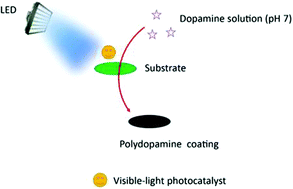Visible-light initiated polymerization of dopamine in a neutral environment for surface coating and visual protein detection†
Abstract
Mussel-inspired polydopamine (PDA) coating is a promising avenue for surface modification. However, the reported methods for PDA deposition require alkaline media, strong oxidation reagents or UV light irradiation. Herein, we report a facile and mild method to prepare PDA in the presence of 9-mesityl-10-methylacridinium ions (Acr+-Mes) as the photocatalyst under visible-light irradiation. The excited-state Acr+-Mes with a high oxidation property and its intermediate which can activate dissolved oxygen enable the oxidation polymerization of dopamine in a neutral environment (pH = 7.0). This approach is easily controlled by switching the visible light (ON/OFF possibility), which can be used to coat several substrates such as polystyrene foam, filter paper, aluminium foil, and glass as well as improve their hydrophilicity. In addition, a visual colorimetric assay is developed for detection of bovine serum albumin. This assay is based on the fact that protein with diverse functional groups serves as the anchor point for PDA deposition that further promotes the oxidation of dopamine, giving rise to a distinct UV-vis absorption change.



 Please wait while we load your content...
Please wait while we load your content...